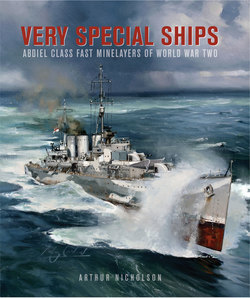Читать книгу Very Special Ships - Arthur Nicholson - Страница 9
На сайте Литреса книга снята с продажи.
ОглавлениеINTRODUCTION
ON 13 August 1940, as the Luftwaffe was unleashing the Blitz on Britain, Captain Edward Pleydell-Bouverie RN sat down to write a letter to his wife Pearl to tell her of his appointment to HMS Abdiel, the name ship of a new class of warship that was then fitting out at J S Stephens & Co at Cowes on the Isle of Wight. Unable to contain himself, he wrote in part:1
All well. I’ve been very busy here . . . I go to a ship, it is signed + sealed. Name is ‘Abdiel’ and she is brand new, won’t be ready for a little while in fact. More than that I can’t say but she’s of a new type and can (or will) go like the very devil. I’ve very pleased I must say to get things settled a bit and . . . this outfit will, I think, be a most independent command in many ways and with every chance of a bit of excitement. You must contain yourself for the rest until Friday.
The Captain had his new ship and his new command perfectly pegged. The Abdiel would indeed ‘go like the very devil’, he was often to have a ‘most independent command’ and he and the crew of the new Abdiel were to experience much more than a ‘bit of excitement’. The very same things could well be said of the other ships of the Abdiel class.
To many, the term ‘minelayer’ is hardly exciting and to some the term ‘fast minelayer’ might sound like an oxymoron. Certainly Norman Goodwin was not expecting much when in March of 1941, as a sixteen-year-old midshipman, he was ordered to report to a new ship, the Abdiel. Having no idea what sort of ship she might be, he was sent to look for her at Gourock on the River Clyde. Upon his arrival there, he was told that she was a fast minelayer, but only the ‘minelayer’ part of the name registered with him. Surveying the ships, he later recalled, ‘There was nothing that looked anything like my conception of a minelayer. I imagined that she would look more like a merchant ship than a warship. I felt a little disappointed. Mine-laying sounded rather a dull occupation.’ All the way in the launch out to the ship, ‘I kept wondering which ship we were going to. It was something of a shock when I realised we were going alongside a grey three-funnelled ship, too big for a destroyer and too small for a cruiser.’ Once aboard, he quickly realised that she was a unique ship and that he had joined an exclusive and elite club that was manned almost completely by regular Royal Navy personnel.2
The fast minelayers were indeed unique, and in that way alone theirs was a bold design. No other ship in any other navy combined their high speed with their capacity to carry not only a useful mine load but much, much more. In the heat of battle and arduous service, their captains and crews turned out to be extraordinary. And, contrary to what Midshipman Goodwin had assumed, minelaying did not turn out to be such a dull occupation, at least not in the fast minelayers.
The Admiralty had high hopes for the fast minelayers and their hopes would be more than fulfilled. The Abdiels were not only fully capable of fulfilling the mission they were designed for, offensive minelaying, but they could also perform many other tasks their designers could have scarcely imagined, such as blockade running, transporting VIPs and more, tasks that mining expert Captain John Cowie would refer to as ‘extraneous’. They would carry out the arduous tasks assigned to them in every ocean and in many of the seas, at storied places like Crete, Tobruk and Malta, in the English Channel, off Normandy and Norway and in the Pacific. In short, the Abdiel class fast minelayers were a brilliant success.
This is their story and the story of the men who sailed in them.
